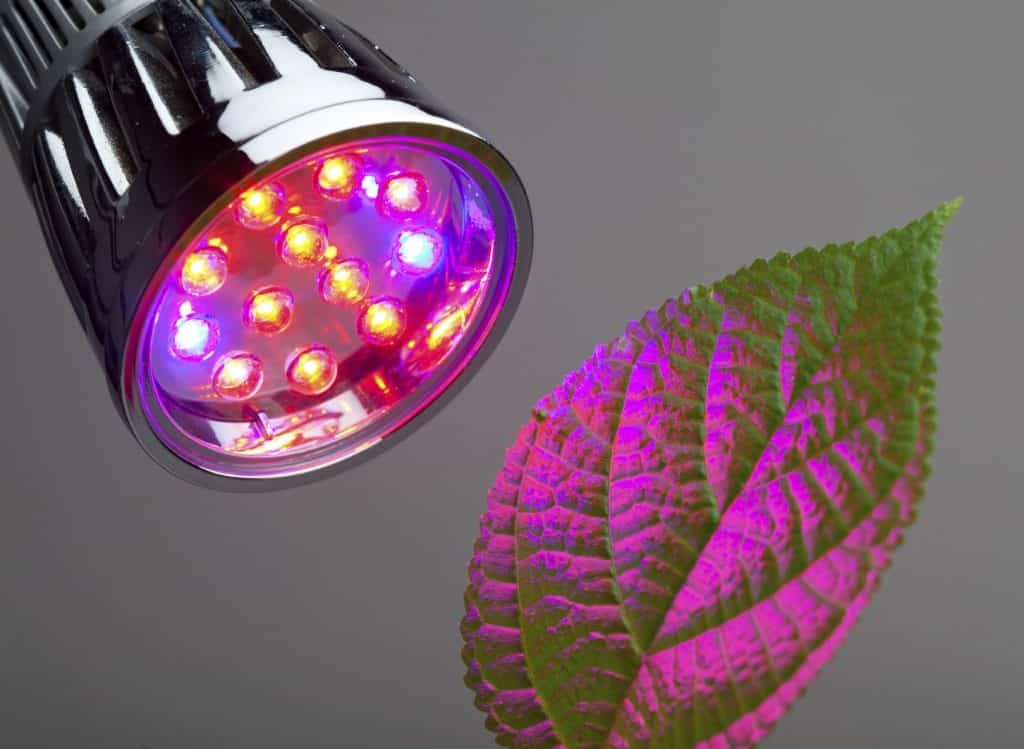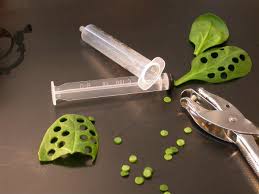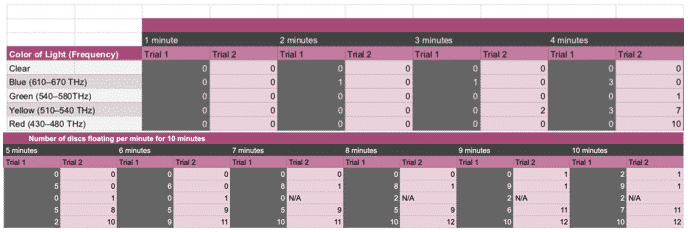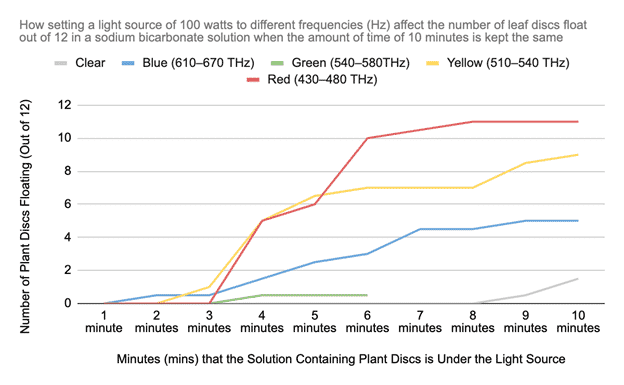Background information:

Photosynthesis is the process in which plants go through to produce energy in the form of glucose required to survive. It is a chemical reaction that involves the use of carbon dioxide, water, and light. This process of photosynthesis takes place in the chloroplasts that are found in the leaves of the plant.
Chloroplasts are small structures that contain a green pigment called chlorophyll. According to BBCbitesize.com, the process involves carbon dioxide entering the leaf through the stomata, located on its underside. Water is absorbed by the plant’s root cells, and transported to the rest of the plant through the use of xylem vessels.
As well as those two components, a plant needs sunlight to undergo the process of photosynthesis. With these three ingredients, photosynthesis occurs, releasing oxygen as a waste product and creating the glucose needed by the plant to feed itself.
We will be conducting an experiment to determine how changing the frequency of the light that a plant uses affects the rate of its photosynthesis by placing discs of the plant in a bicarbonate soap solution under lights of different frequencies and recording the number of discs that float up after a certain amount of time.
The leaf discs will float up because of the oxygen emitted by them as a waste product of photosynthesis, and this will help us conclude the photosynthesis rate based on how much oxygen is released by the discs and how much time it takes them to float to the surface.
Research Question:
How does setting a light source of 100 watts to different frequencies (430–480 THz, 510–540 THz, 540–580THz, 610–670 THz, clear light) affect the number of leaf discs float out of 12 in a sodium bicarbonate solution when the amount of time of 10 minutes is kept the same?
Hypothesis:
My hypothesis is that if a light source of 100 watts above the plant discs is changed to the different frequencies of Red Light (430–480 THz), Blue Light (610–670 THz), Yellow Light (510–540 THz), Green Light (540–580THz), and Clear Light, the number of leaf discs out of 12 floating in the bicarbonate solution over time will differ.
I predict that since, according to Edriaan Koening on sciencing.com, the pigments in a plant [1] – chlorophyll a, chlorophyll b, and β-carotene – all absorb wavelengths of the color blue and red the most, photosynthesis rate will increase in the plant discs under the red and blue lights, causing more of them to float after the period of time of 10 minutes compared to other colors of light. I presume that yes, setting the light source to a different light frequency will affect the number of discs floating after a period of time.
Independent variable (IV):
The independent variable in this experiment is the frequency of the light that will be used on the plant discs. We will attain different frequencies (Hz) of light by using different light filters on a light source of 100 watts above the plant. We will be using Red Light (430–480 THz), Blue Light (610–670 THz), Green Light (540–580THz), Yellow Light (510–540 THz), and Clear Light. We will create those frequencies by placing cellophane filters of each of the colors against the light source.
Dependent variable (DV):
By changing the independent variable, in this case, is the frequency of Red Light (430–480 THz), Blue Light (610–670 THz), Green Light (540–580THz), Yellow Light (510–540 THz), and Clear Light, the number of discs that float out of 12 will change over a time period of 10 minutes. This will be measured by counting the number of floating discs under different-colored lights after a certain amount of time which will be measured through the use of a timer. We will be conducting 2 trials to observe the floating of the plant discs for each of the colored cellophane filters, and we will calculate the average of the data recorded for the time it took the plant discs to float to the surface.
Control variables:
| Variable | How it will be measured | Why it should be controlled |
| The time in which the lights above the plant discs will be kept on. | The time that the lights will be kept on is ten minutes. We will measure this through the use of a timer or stopwatch. | This is an important variable to be controlled because it has a large impact on the results. Conducting the experiment for a longer time may cause more or different reactions in the plant discs. If some plant discs get light for a larger amount of time than others the extent of the reaction that occurs may differ. |
| Size of the plant discs cut out. | This will be kept the same through the use of a hole puncher. A hole puncher will create identical duplicates of plant discs. | It is important for the discs to maintain the same dimensions and weight so that the experiment is not affected because plant discs of different sizes will vary in the number of chloroplasts they contain and therefore conduct photosynthesis at different rates which means that results that will be collected in this experiment will be inaccurate. According to Kim Foglia and Brad Wilson on gulfcoast.edu,another thing that has to be kept in mind as well as making the plant discs the same size is that they come from similar parts of the leaves. |
| Type of plant used for the plant discs. | We will keep this the same simply by using only one type of plant for the experiment. | Different types of plants will undergo photosynthesis at different rates because there are different types of plants; “sun plants”, which will absorb a lot of light, therefore increasing their photosynthesis rates, and “shade plants”, which photosynthesize at a lower rate even when exposed to a lot of light (University of Florida, “Photosynthesis”). This along with the fact that different types of plants differ in thickness, texture, surface area, and so many different elements that definitely have an effect on their efficiency when conducting the process of photosynthesis. |
| Light source | We will keep the light source the same in this experiment by using the same lamp throughout the whole experiment and making sure that we do not change it. | We should keep the light source the same because light bulbs may differ in the number of watts they emit. If we have some plant discs under a light source that emits 50Ws, and some other plant discs under a light of 100Ws, then some plant discs will be getting a larger amount of light and will be able to photosynthesize in a more efficient manner than the other plant discs that are exposed to less light. |
| Room temperature | We will maintain the room temperature by making sure that we are conducting the experiment in the same room all throughout, and that the air conditioning is set at the same temperature from the beginning till the end. | This is important to keep the same because temperature is a factor that affects a plant’s photosynthesis. Changing the temperature, therefore changing the photosynthesis rates in the plant disc, will result in inaccurate data. |
| Water temperature | We will be checking that the water remains a consistent temperature of 20° Celcius throughout the experiment through the use of a thermometer. This will enable us to know whether we have to heat or cool the water if we find that the water temperature is not 20° all throughout the trials. | We will need to keep a consistent temperature in the water in which the bicarbonate and soap solution is made in for this experiment because according to Samuel Markings on sciencing.com, photosynthesis occurs at different rates depending on the temperature [2] a plant is exposed to, similar to keeping the room temperature consistent. If we change either of these temperatures during our experiment, the plant discs may react in ways that they wouldn’t have if everything had stayed the same – meaning inaccurate results. |
Apparatus List:

- 1 hole puncher
- Spinach leaves or ivy leaves
- 5 cellophane filters in the colors red, blue, green and yellow
- Sodium Bicarbonate (baking soda)
- 1 pipette
- 1 roll of tape
- 2 250ml beakers
- 1 ruler
- 1 Thermometer
- 1 marker (any color)
- Dish soap, preferably clear-colored
- 1 disposable 10ml syringe with no needle
- 1 timer
- 1 light source that emits white light, such as a lamp (LED light) (100 watts)
- 1 glass stirring rod (spoon can also be used)
Safety Considerations:
- Wear proper lab attire that covers most of the body, especially the legs.
- Do not wear open-footed shoes. Footwear should cover feet completely.
- Remove or secure dangling items such as jewelry.
- If hair is chin-length or longer, make sure it is tied back.
- Wear safety goggles at all times during the experiment.
- Do not consume any of the materials used in the experiment.
- Make sure that none of the materials come in contact with your eyes during the experiment.
- Be careful when handling the hole puncher. Refrain from putting your fingers under it.
- Be alert of your workspace. Make sure none of the glass material is in danger of falling.
- Do not allow any solvent to come in contact with skin. Wear latex gloves if possible.
In Case of Injury:
- If any material or substance is consumed seek an adult or, in cases of pain and symptoms, seek professional medical attention immediately.
- In case of a flesh wound, seek an adult for help, wash the wound, apply antibiotic cream, and cover using a plaster. In case of persistent pain or signs of infection, seek professional medical attention immediately. (mayoclinic.org[3] , “Cuts and Scrapes: First-Aid”)
Method:
- The first step in this experiment is making the bicarbonate and soap solution: Use the ruler and marker to mark a six-centimeter point on both of the beakers, then fill the beakers up to that point with 20° Celcius tap water using the thermometer to measure the temperature of the water as to keep it consistent. If water is used for other trials of experiment differs to previous temperatures, find a way to heat or cool it.
- Add a pinch (around 0.4g – you may use your measuring scale to get an exact amount) of baking soda and stir with the glass stirring rod to the beakers.
- Add a drop of dish soap using the pipette and stir with the glass stirring rod to the solution in the beakers. This is done to penetrate through the plant disc’s hydrophobic surface, allowing the solution to be absorbed into the leaf, and therefore enabling it to sink into the solution. It is critical to avoid soap suds to form in this step. If suds are formed, dilute the solution with more bicarbonate. (Kim Foglia and Brad Wilson, gulfcoast.edu)
- Secondly, using the hole punch, cut out 12 discs from the spinach leaves for each color of the cellophane filters. Try to avoid the midrib and veins when cutting out the discs. Aim for your leaf discs to be smooth and around the same thickness.
- Third, take the syringe, remove its plunger, and place one of the sets of leaf discs (12 discs) in the syringe. Put the plunger back in the syringe, leaving a small space above the leaf discs as to not squish them (a space of <10%). Fill up the syringe with the solution in the beakers you have prepared in the first step to 20ml.
- The next step is to create a vacuum to extract the oxygen out of the spongy mesophyll in the spinach leaf discs using the syringe we have prepared in the previous step to allow the leaf discs to sink in the solution:
- Point the syringe vertically.
- If there is an air bubble at the top of the syringe, push the plunger up slightly so that the solution reaches the top and pushes the oxygen out.
- Cover the open tip of the syringe with your finger.
- Tap the syringe gently so that the leaf discs are well covered in the solution.
- Pull the plunger back, creating the vacuum and sucking the oxygen out of the leaf discs, replacing it with the bicarbonate and soap solution.
- Hold the vacuum for around 10 seconds.
- Check to see if any of the leaf discs are still floating. If there are any, keep your finger on the top of the syringe and shake it until all leaf discs sink, by doing this, you are making sure that no oxygen remains in any of the leaf discs and that they are full of the solution.
- If you are not able to cause the leaf discs to float after 3 tries of creating a vacuum, add a few more drops of soap. Do not create more than 3 vacuums, as the plant discs could get damaged (Brad Williamson, elbiology.com).
- After that, remove the syringe’s plunger and spill its content out into the beakers containing the bicarbonate and soap solution.
- Place the cup under the light source, and record the number of leaf disks floating every 1 minute for 25 minutes.
- Once all discs are floating or 10 minutes are over:
- Dispose of the bicarbonate and soap solution and clean out the cup and syringe.
- Repeat steps 1-7 twice, taping a different colored cellophane filter on the light source each repeat of the steps.
- Repeat this step until you have collected data for the number of floating discs after 25 minutes under each color of the cellophane filters on the light source.
Raw Data Table:

Data Processing and Calculations:
We will be calculating the averages of the time it has taken the plant discs to float up to the surface per minute in both of the trials for every light frequency. The formula we will use to achieve this is dividing the sum of the terms by the number of terms.
For example, if we take the 7th minute of plant discs under a red light of 430-480 THz, we will need to find out the sum of its terms. It can be seen that 10 plant discs have floated to the surface of the bicarbonate and soap solution in the first trial, and in the second trial, 11 have floated up on the 7th minute. We find the sum of the two numbers, which is 21, then divide said number by the number of terms – which in this case is 2. 21 divided by 2 is 10.5.
Therefore, on the 7th minute under a light of the frequency 430-480 THz, an average of 10.5 plant discs have floated up to the surface.
Processed Data Table:

Graph:

Interpretation of Results:
In the graph, it can be seen that there is a general pattern in which the number of floating plant discs increases as time increases. This is due to the fact that the plant discs are using the CO2 in the bicarbonate solution they are floating in to conduct photosynthesis, producing oxygen bubbles. If these plant discs are placed under a light source, it is inevitable that they will eventually float up due to their need to go through the process of photosynthesis.
It can also be observed that the rate of photosynthesis in the plant discs varies depending on the light frequency it is under, providing us with the answer to the research question that led us to conduct the experiment. Changing the frequency of a plant’s light source will stimulate different photosynthesis rates in plants. We can see that in the graph representing the data table’s results that the most amount of plant discs have floated to the surface of the solution in the least amount of time was the plant discs in the solution under the red light.
I assume that this occurred because based on what I deduct from Sciencing.com, red light is one of the certain wavelengths that special pigments in the chloroplasts of a plant will absorb, therefore accelerating the process of photosynthesis in the plant discs under it. I can also see that, in the data tables, there are major differences between the results recorded for the first and seconds trials.
The data for the first trial for the plants under the red light shows that the plant discs only started to float up at the 5-minute mark, and not all of the plant discs had floated by the end of the 10 minutes. When comparing this to the second trial under the same frequency of light, the results show 10 plant discs having floated up by the fourth minute.
We can assume that something has gone wrong during the experiment, as not only do the results to the two trials differ greatly, but there was a sudden surge of floating plant discs in the second trial after there being no plant discs floating for 4 minutes straight. The data may have been recorded incorrectly, or plant discs may have gotten stuck to the sides of the beaker they were in before being able to float up.
Discussion of Hypothesis:
In my hypothesis, I had predicted that photosynthesis rate will increase in the plant discs under the red and blue lights, causing an increase in the number of floating discs after the period of time of 10 minutes compared to other colors of light due to the fact that the pigments in a plant – chlorophyll a, chlorophyll b, and β-carotene – all absorb wavelengths of the color blue and red the most as they cause more molecular chain reactions (Vernier.com). My hypothesis was partially correct.
I had predicted that plant discs under a light source of the red and blue frequencies would float faster based on previous knowledge and research about the topic, but it seems that the experiment had not supported the hypothesis. It can be seen in the data tables that although red light elicited the highest rate of photosynthesis within the plant discs, blue light did not seem to have a similar effect as expected, which leads me to think that something may have gone wrong during the experiment since my hypothesis was based on trust-worthy sources and knowledge I had gained from experts.
Though the experiment did support the point in my hypothesis in which I stated that the photosynthesis rates of the plant discs would differ, causing them to float at different speeds based on the frequency of their light source. This can be perceived by observing the graph of the experiment’s results. We can see that the data displayed for each light color is different, going up at different rates and going up to certain points.
Discussion of Method:
I think that the method I have used in this experiment was valid in a lot of ways, but did have its limitations. The method I had described explained each process in detail, in addition to suggesting alternative ways to conduct the experiment and what to do in case something does not go as planned; for example, if the person is not able to create a successful vacuum, they should add a few drops of soap until they succeed, as well as warning them that the vacuum should not be repeated 3 times as it could damage the leaf discs.
A limitation that I have only realized now is how time-consuming I have made the experiment. The participant was required to make 15 discs for every light frequency used in the experiment – twice, as there are two trials. They were also required to create two bicarbonate and soap solutions for every color of light in the experiment because in the apparatus list I had only asked them to use two beakers throughout the whole experiment for all the light colors and all the trials.
Not only would this tax the participant of time but also effort. Another limitation in my method is that for an experiment to be successful and for its results to be credible, three trials are required, whereas in my method I had only done two trials. By conducting three trials, it can be made sure that the results deduced from the experiment are consistent and not altered by random events. (Richmond Public School).
Improvements/recommendations:
| Improvements to consider: | Why/How it should be improved: |
| Number of trials. | This is a very important aspect of the experiment that should definitely be improved as it is essential in conducting any proper experiment. Next time, instead of conducting two trials for each light frequency, we will be conducting three trials so that, as I have mentioned before, it can be made sure that the results deduced from the experiment are consistent and not altered by random events. |
| Thickness of plant discs. | The thickness of the plant discs may have influenced the results of the experiment, as some plant discs may have had more chloroplasts than other due to the fact that they are larger, resulting in them undergoing the process of photosynthesis at a faster rate, thus floating to the surface faster than other plant discs. A way to avoid this happening would be to weigh each other plant discs, making sure that they are consistent in weight. |
| Room light. | The experiment should be conducted in a room that is pitch black so that the only light that will be absorbed by the plant discs will be the one coming from the light source above it. A light source outside. of the one presented to the plant discs would influence the results because the plant discs will not only be getting the frequency they are supposed to be getting |
Bibliography
Cpb-Us-E1.Wpmucdn.Com, 2020, https://cpb-us-e1.wpmucdn.comlogs.cornell.edu/dist/3/1009/files/2015/09/Floating-Leaf-Disk-Brad-Williamson.pdf.
“Photosynthesis”. Www2.Nau.Edu, 2020, http://www2.nau.edu/lrm22/lessons/photosynthesis/photosynthesis.html.
“Photosynthetic Floatation”. Exploratorium, 2020, https://www.exploratorium.edu/snacks/photosynthetic-floatation.
“Wavelengths Of Light That Are Most Effective For Photosynthesis”. Sciencing, 2020, https://sciencing.com/wavelengths-of-light-that-are-most-effective-for-photosynthesis-12405703.html.
“What Are The Best Light Sources For Photosynthesis? – Vernier”. Vernier, 2020, https://www.vernier.com/2018/09/04/what-are-the-best-light-sources-for-photosynthesis/.
Khan, Sal. “Wavelengths Of Light And Photosynthetic Pigments (Article) | Khan Academy”. Khan Academy, 2020, https://www.khanacademy.org/science/biology/photosynthesis-in-plants/the-light-dependent-reactions-of-photosynthesis/a/light-and-photosynthetic-pigments.
Koening, Edriaan. “What Color Of Light Do Plants Absorb?”. Sciencing, 2020, https://sciencing.com/what-color-of-light-do-plants-absorb-13428149.html.
ksbioteacher. Sinking Leaf Disks. 2012, https://www.youtube.com/watch?v=vw8baZO89oc&feature=emb_logo. Accessed 28 May 2020.

hey that’s mine :)! glad it made it on here